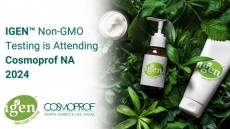2024 beauty ingredient trends: Spate Co-Founder's insights on meeting consumer demand

The beauty industry constantly evolves, with ingredient trends pivotal in shaping consumer expectations and driving product innovation. As consumers continue to become increasingly knowledgeable and demanding, they seek products that deliver on promises and align with their broader lifestyle values.
The growing interest in scientifically backed and multifunctional ingredients reflects this shift, influencing how brands develop and market their products. We spoke to Yarden Horwitz, co-founder of Spate, for her insights into these emerging trends and guidance on how beauty brands can stay ahead of the curve in a rapidly changing market.
Rising demand for scientifically backed ingredients
“Current trends in beauty ingredients focus on the increasing demand for scientifically backed and multifunctional components,” Horwitz began, with key ingredients like vitamin C, hyaluronic acid, and glycolic acid showing “significantly increased search volume due to their proven effectiveness and consumer trust” in Spate’s recent research.
Additionally, “emerging ingredients such as snail mucin, heartleaf, and red bean, driven by the cultural influence of K-beauty, are also gaining traction.” As Horwtiz explained, these ingredients have recently shown increased favor with consumers as shoppers seek “products that deliver visible results, address multiple skin concerns, and have international appeal.”
Opportunities for innovation across beauty categories
The shift towards versatile ingredients presents significant opportunities for innovation across various beauty product categories, including skin care, hair care, and body care. Horwitz highlighted the potential for brands to leverage these trends, noting that “brands can develop products incorporating versatile ingredients like peptides, hyaluronic acid, and glycolic acid across skin care, hair care, and body care categories,” appealing to consumers seeking comprehensive solutions.
Horwitz suggested that these ingredients can be used in serums, moisturizers, and treatments targeting anti-aging, hydration, and exfoliation. In hair care, they can enhance shampoos, conditioners, and hair masks to promote scalp health, hair strength, and shine. For body care, incorporating these ingredients into lotions, exfoliators, and washes can improve skin texture, hydration, and overall appearance, providing consistent benefits throughout a consumer’s beauty routine, she added.
Horwitz advised brands to “partner with scientific and clinical experts to validate the efficacy of new ingredients and formulations” as they develop new products. Further, she added, “The popularity of K-beauty ingredients like snail mucin and heartleaf offers an opportunity for brands to integrate culturally significant components from different regions, enhancing product diversity.”
Additionally, Horwitz emphasized the growing consumer demand for “eco-friendly and ethically sourced ingredients, including lab-derived alternatives to natural components,” which can attract environmentally conscious consumers and position brands as leaders in sustainability.
Preparing for future trends & consumer preferences
As consumer behavior evolves rapidly, staying ahead of trends is critical for beauty brands. “Consumer behavior is evolving faster than ever, making it crucial for brands to stay attuned to consumer trends to maintain relevance,” said Horwitz. She suggested that brands leverage data from platforms like Google Search and TikTok to predict future ingredient popularity and consumer needs in real-time, enabling them to stay ahead of emerging trends.
Horwitz recommends that brands “identify relevant claims and concerns to align with and seek out early-stage ingredients associated with these terms to capitalize on future trends.” This strategy allows brands to position themselves alongside an ingredient trend before fully committing to product development, giving them an edge over competitors.
Horwitz also underscored the importance of investing in research and development to stay ahead with innovative formulations and collaborating with suppliers and industry experts to access high-quality ingredients.
Effective communication is another crucial aspect of staying ahead in the beauty industry. Horwitz highlighted the need for brands to “develop effective communication strategies highlighting the benefits and uniqueness of emerging ingredients,” which can help educate consumers and build brand trust.
As beauty ingredient trends shift in response to consumer demand, staying attuned to consumer preferences and innovating accordingly will be essential for brands looking to maintain relevance and drive growth in the competitive beauty market. By focusing on scientifically backed ingredients, embracing versatile components across product categories, and preparing for future trends, beauty brands can effectively meet consumer expectations and position themselves for success.

















